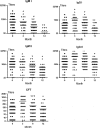One-year follow-up of patients of the ongoing Dutch Q fever outbreak: clinical, serological and echocardiographic findings
- PMID: 20857313
- PMCID: PMC3003145
- DOI: 10.1007/s15010-010-0052-x
One-year follow-up of patients of the ongoing Dutch Q fever outbreak: clinical, serological and echocardiographic findings
Abstract
Purpose: In 2007, a large goat-farming-associated Q fever outbreak occurred in the Netherlands. Data on the clinical outcome of Dutch Q fever patients are lacking. The current advocated follow-up strategy includes serological follow-up to detect evolution to chronic disease and cardiac screening at baseline to identify and prophylactically treat Q fever patients in case of valvulopathy. However, serological follow-up using commercially available tests is complicated by the lack of validated cut-off values. Furthermore, cardiac screening in the setting of a large outbreak has not been implemented previously. Therefore, we report here the clinical outcome, serological follow-up and cardiac screening data of the Q fever patients of the current ongoing outbreak.
Methods: The implementation of a protocol including clinical and serological follow-up at baseline and 3, 6 and 12 months after acute Q fever and screening echocardiography at baseline.
Results: Eighty-five patients with acute Q fever were identified (male 62%, female 38%). An aspecific, flu-like illness was the most common clinical presentation. Persistent symptoms after acute Q fever were reported by 59% of patients at 6 months and 30% at 12 months follow-up. We observed a typical serological response to Coxiella burnetii infection in both anti-phase I and anti-phase II IgG antibodies, with an increase in antibody titres up to 3 months and a subsequent decrease in the following 9 months. Screening echocardiography was available for 66 (78%) out of 85 Q fever patients. Cardiac valvulopathy was present in 39 (59%) patients. None of the 85 patients developed chronic Q fever.
Conclusions: Clinical, serological and echocardiographic data of the current ongoing Dutch Q fever outbreak cohort are presented. Screening echocardiography is no longer part of the standard work-up of Q fever patients in the Netherlands.
Figures
References
-
- Karagiannis I, Morroy G, Rietveld A, et al. Q fever outbreak in the Netherlands: a preliminary report. Euro Surveill. 2007;12:E070809.2–2003. - PubMed
-
- Van Steenbergen JE, Morroy G, Groot CA, et al. An outbreak of Q fever in The Netherlands—possible link to goats. Ned Tijdschr Geneeskd. 2007;151:1998–2003. - PubMed
MeSH terms
LinkOut - more resources
Full Text Sources


